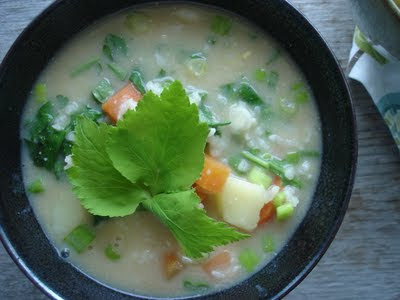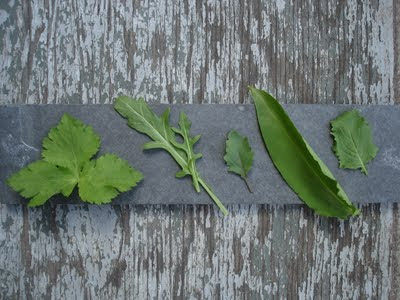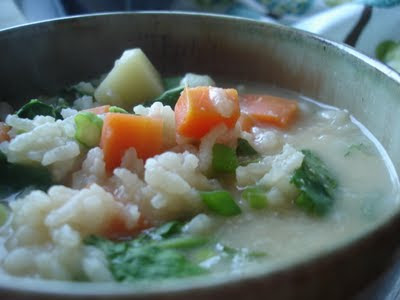A Little Warmth in the Tummy
The unseasonal chill seems to be finally lifting from Southern Quebec, however the wet weather is still sticking around for a while. I know I shouldn't be complaining: I live neither in a flood zone nor near a rabid wild fire. Although I doubt I will be able to do much gardening this week-end, despite it being the official cut-off date for frost in the region, it's not like I depend on my crop for survival: my thoughts go out to the farmers and growers who cannot sow for the wet, and the bee keepers whose hives are on 'strike' due to the cold. Despite predictions of a hot summer, I think we need to brace ourselves for a hard season ahead.
I suppose I've got it good - my only worry is nursing this nagging cold. As I've mentioned before, when sick, I turn to tried and tested comfort foods. It's unfortunate that one cannot live on pudding alone: one occasionally needs actual nourishment. Gruel is an awful sounding word, but when done right, gruel can be the perfect, cockles warming comfort food. In its plainest form, it will convey easily digested nutrients, but a few embellishments turns into a complete meal. Best of all, gruel makes good use of left-overs and mystery vegetables found at the bottom of the fridge.
Almost every culture has some form of porridge -the oatmeal of Anglo-Saxons; kasha in Eastern Europe; and various other hot cereals we consume for breakfast. Just about every Asian country uses rice as a base. In Japan, there are two types of rice gruel: okayu starts out with raw rice, whereas ojiya makes good use of left-over cooked rice. In fact, I am sure that you can make something similar with any left-over cooked grain. There are no hard and fast rules to making rice porridge, although I am sure that my mum would disagree... I use plain water, she always uses dashi, the Japanese stock made with bonito and kombu. I rely on the added vegetables to contribute lots of flavour to the gruel.
At this time of the year, my obvious choice of vegetables are the 'wild' greens I find in my garden. Namely, mitsuba (also called Japanese parsley, even though its flavour is nothing like parsley); wild roquette (a perennial that is unrelated to arugula, but tastes similar); baby kale leaves; wild garlic; and radish greens. Of course, anything you happen to have on hand will contribute to the porridge, whether it is the lone carrot at the bottom of the crisper drawer, or the sprouting potatoes in the pantry, or even the wilting green onions that were forgotten on the kitchen counter (I am, of course, merely observing the desolate scene that is my kitchen at the moment...)
Fiddleheads are currently in season, and are a scrumptious addition once they've been parboiled. Do not keep the fiddleheads' blanching water -it will turn a dark purpley-black, and tastes awful; instead pour it over your houseplants when cool. Fiddlehead (ostrich) ferns are endemic to North-Eastern North America, but the Japanese do eat other varieties of ferns, so the twirly vegetables will not be out of place in a bowl of ojiya. (By the way, never having been out West in the spring, I am completely clueless as to the wild foods available at this time of the year. Any ideas?) Another wild food abundant right now are dandelion greens: by now, they will have attained a size and bitterness that renders them difficult for eating raw, but they will be lovely cooked.
There is one last ingredient I like t include in ojiya: miso. Miso has practically become common knowledge nowadays, especially if you happen to have vegetarians or eco-hippies in your circle of friends. For those who are still unfamiliar with this Japanese condiment, miso is a paste of fermented soybeans, malted rice, and occasionally, another grain. It tastes slightly alcoholic, but its main contributing factor is the savoury saltiness it imparts to foods. It is a great base for soups and vegetarian stews. I also like to use it as a dip for cucumbers. Miso can be found in most Asian grocery and health food stores. If you are new to miso, I recommend you begin with white (shiro) miso, as it is the mildest and slightly sweet. Red (aka) miso is second in line, and what is most often used. The darker the paste, the stronger the flavour, so use in consequence. One last, yet very important, point on miso: never cook the paste. It should be added at the very end of the cooking process, and never brought to a boil, as it alters the flavour.
I suppose I've got it good - my only worry is nursing this nagging cold. As I've mentioned before, when sick, I turn to tried and tested comfort foods. It's unfortunate that one cannot live on pudding alone: one occasionally needs actual nourishment. Gruel is an awful sounding word, but when done right, gruel can be the perfect, cockles warming comfort food. In its plainest form, it will convey easily digested nutrients, but a few embellishments turns into a complete meal. Best of all, gruel makes good use of left-overs and mystery vegetables found at the bottom of the fridge.
Almost every culture has some form of porridge -the oatmeal of Anglo-Saxons; kasha in Eastern Europe; and various other hot cereals we consume for breakfast. Just about every Asian country uses rice as a base. In Japan, there are two types of rice gruel: okayu starts out with raw rice, whereas ojiya makes good use of left-over cooked rice. In fact, I am sure that you can make something similar with any left-over cooked grain. There are no hard and fast rules to making rice porridge, although I am sure that my mum would disagree... I use plain water, she always uses dashi, the Japanese stock made with bonito and kombu. I rely on the added vegetables to contribute lots of flavour to the gruel.
At this time of the year, my obvious choice of vegetables are the 'wild' greens I find in my garden. Namely, mitsuba (also called Japanese parsley, even though its flavour is nothing like parsley); wild roquette (a perennial that is unrelated to arugula, but tastes similar); baby kale leaves; wild garlic; and radish greens. Of course, anything you happen to have on hand will contribute to the porridge, whether it is the lone carrot at the bottom of the crisper drawer, or the sprouting potatoes in the pantry, or even the wilting green onions that were forgotten on the kitchen counter (I am, of course, merely observing the desolate scene that is my kitchen at the moment...)
Fiddleheads are currently in season, and are a scrumptious addition once they've been parboiled. Do not keep the fiddleheads' blanching water -it will turn a dark purpley-black, and tastes awful; instead pour it over your houseplants when cool. Fiddlehead (ostrich) ferns are endemic to North-Eastern North America, but the Japanese do eat other varieties of ferns, so the twirly vegetables will not be out of place in a bowl of ojiya. (By the way, never having been out West in the spring, I am completely clueless as to the wild foods available at this time of the year. Any ideas?) Another wild food abundant right now are dandelion greens: by now, they will have attained a size and bitterness that renders them difficult for eating raw, but they will be lovely cooked.
There is one last ingredient I like t include in ojiya: miso. Miso has practically become common knowledge nowadays, especially if you happen to have vegetarians or eco-hippies in your circle of friends. For those who are still unfamiliar with this Japanese condiment, miso is a paste of fermented soybeans, malted rice, and occasionally, another grain. It tastes slightly alcoholic, but its main contributing factor is the savoury saltiness it imparts to foods. It is a great base for soups and vegetarian stews. I also like to use it as a dip for cucumbers. Miso can be found in most Asian grocery and health food stores. If you are new to miso, I recommend you begin with white (shiro) miso, as it is the mildest and slightly sweet. Red (aka) miso is second in line, and what is most often used. The darker the paste, the stronger the flavour, so use in consequence. One last, yet very important, point on miso: never cook the paste. It should be added at the very end of the cooking process, and never brought to a boil, as it alters the flavour.
Ojiya
For one
120g/ ±1cup cooked rice
125ml/ 1cup water
1 heaping Tbs miso paste, optional
1 heaping cup chopped, mixed vegetables
Bring the water up to the boil, and cook the vegetables: any greens should be added at the end.
When the vegetables are tender, add the rice, and simmer until the grains swell up and are warmed through.
Add any greens, and turn the heat down to low.
In a bowl, thin out the miso paste with some of the gruel, until it is quite runny. Add to the pot.
Consume immediately.
Feel better.
Eventually, the weather will warm up, and there will be a less pressing need for hot porridge, but one never knows... One can get chilled with all the rampant air-conditioning. I would omit the miso when using summer vegetables, such as tomatoes (a few sprigs of basil or shiso would be lovely.) When autumn returns, squashes and sweet potatoes will have place of honour, but lets not think that far ahead. You can also add proteins if you like: fish and seafood are obvious choices, added at the end, just before the miso, so that it just barely cooked. However, any other left-over meat or even a poached egg are likely to be scrumptious, just leave out the miso.
Bon app'!
For one
120g/ ±1cup cooked rice
125ml/ 1cup water
1 heaping Tbs miso paste, optional
1 heaping cup chopped, mixed vegetables
Bring the water up to the boil, and cook the vegetables: any greens should be added at the end.
When the vegetables are tender, add the rice, and simmer until the grains swell up and are warmed through.
Add any greens, and turn the heat down to low.
In a bowl, thin out the miso paste with some of the gruel, until it is quite runny. Add to the pot.
Consume immediately.
Feel better.
Eventually, the weather will warm up, and there will be a less pressing need for hot porridge, but one never knows... One can get chilled with all the rampant air-conditioning. I would omit the miso when using summer vegetables, such as tomatoes (a few sprigs of basil or shiso would be lovely.) When autumn returns, squashes and sweet potatoes will have place of honour, but lets not think that far ahead. You can also add proteins if you like: fish and seafood are obvious choices, added at the end, just before the miso, so that it just barely cooked. However, any other left-over meat or even a poached egg are likely to be scrumptious, just leave out the miso.
Bon app'!







hopped over here after reading your comment on EcoMama...love it that you incorporate green into your food blog! and how did you know that I've got some unopened miso intimidating me from the fridge? ;)
ReplyDelete